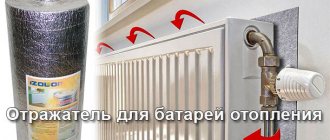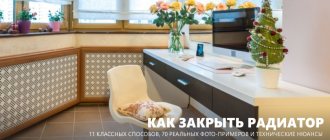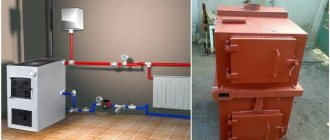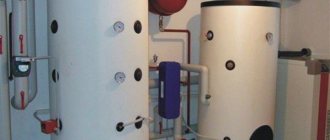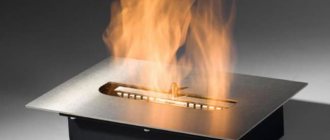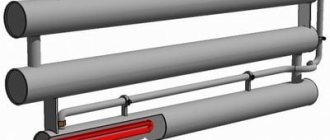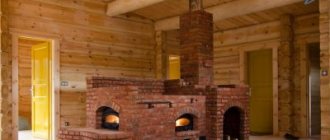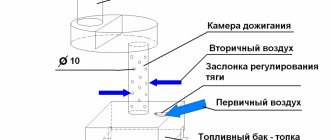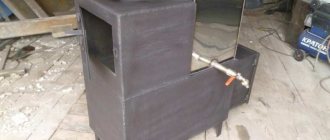Why do we need screens for heating radiators?
The screen installed on the convector performs several functions:
- protective;
- decorative;
- heat-conducting;
- hygienic.
The buyer's priorities may be placed in a different order, but each item is important.
Defense tasks
The battery grill protects both the device itself and the occupants of the home:
- You can hit the edges of the sections, shut-off valves and thermostat;
- large dogs can destroy pipes, causing home flooding;
- the convector heats up to high temperatures, which can cause burns;
- The rescue service reports frequent cases where a child's arm or leg gets stuck between the sections.
When furniture is moved or objects fall, impacts sometimes occur on the heat exchanger, which can lead to damage to the appearance or cracking of sections.
How to actually choose the cheapest heating radiators on the market
Decorative functions
Unsightly radiators can be covered with curtains, but this will reduce heating efficiency.
By choosing the right screen, you can emphasize the stylistic design of your home by hiding the radiator, pipes, shut-off and control valves.
The screen is an assistant in the fight against dirt
There are tools that allow you to clean the radiator from dust in hard-to-reach places, but even with their help it is impossible to remove dust from all areas.
The heating radiator works like a convector - air flows rise from the floor along the edges of the sections. At the same time, dust and pet hair settle on hard-to-reach surfaces of the battery, which are difficult to remove due to the structure of the sections.
The screens partially “filter” air flows, and it is not difficult to remove dust from their front wall.
Coloring, art painting
The technique is considered one of the most attractive from the point of view of maintaining the amount of heat transfer. In addition, it does not require installation work to install the box. The disadvantage is that painting the radiator is not safe for children. The sharp metal corners of the radiator will remain uncovered.
Artistic painting Source stat01.com
The range of varieties of heat-resistant paints allows you to choose the color that best suits your interior and quickly paint over the white surface of the radiator. The result will not be long in coming, even if it is not possible to completely replicate the background of the walls. A little lighter or darker – it doesn’t matter. The main thing is that this is no longer a white “spot” against the background of, for example, a dark wall.
It is not necessary to give the batteries the color of the wall surfaces. With their help you can create a unique decorative element. It is enough to draw a burning fireplace, a shelf with some object or something else on them. The drawing can be different, from a banal image of a piece of furniture to an original landscape or still life.
Effect on thermal output
Ideally, the screen should not affect the heat exchange between the battery and air. However, any design impedes air circulation and partially blocks the paths of thermal radiation.
Changes in the thermal power of the radiator depending on the placement and presence of a screen.
It is important to meet the following conditions:
- leave a ventilation gap of at least 60 mm from the floor across the entire width of the radiator;
- provide a hole at the top for the exit of heated air;
- maintain a distance from the sections to the front wall of the screen of at least 50 mm;
- choose a screen with a front wall, at least 50% of the area of which is filled with through holes;
- give preference to easily removable screens that can be easily dismantled on particularly cold days to improve heat transfer and also for cleaning.
It is advisable to paint the inner surface of metal screens black - this will contribute to its rapid heating and increased heat transfer by emitting infrared waves.
Several important requirements for decorative screens
In addition to the conditions mentioned above, when choosing a decorative panel, you should take into account several more important points that ensure sufficient heat transfer from heating radiators.
- The material from which the screen or grille is made must have good thermal conductivity. This is a necessary condition so that the heat does not linger in the space between the surfaces of the battery and the panel, but passes freely into the room.
- It is recommended to paint the inside of the decorative panel in a dark color, dark brown or black - this factor will contribute to good absorption of heat emanating from the radiator and transferring it to the room. The front side of the panel can be painted in any shade that best suits the overall color scheme of the room.
The simplest device - a reflective screen made of thin foil insulation - can significantly increase the heat transfer efficiency of radiators
- Another device that will help save thermal energy from unproductive escape into the external wall can be a heat-reflecting screen. It is mounted on the wall, behind the radiator. Most often, foil-foamed polyethylene with a thickness of 3÷5 mm is used as this device. The insulation is fixed with the reflective surface facing outwards. Thus, all the heat emanating from the radiator will be directed towards the room, which will enhance its passage through the decorative panel.
If the radiators have yet to be installed, then instead of thin polyethylene, you can fix foil foam 10 mm thick on the wall. This material will help significantly save on heating costs.
You might be interested in information about what paint is suitable for heating pipes
Screen manufacturing options
All types of screens can be classified according to several criteria:
- material of manufacture;
- installation method: built-in, wall-mounted and attached;
- design: with or without a lid, flat or boxes, etc.
The type and appearance are chosen based on the criteria of functionality, appearance and price.
Metal
Steel screens have such positive qualities as:
- variety of shapes and colors;
- unlimited service life;
- minimal thermal deformation and color fastness;
- good thermal conductivity, allowing heated screens to re-radiate heat rays;
- strength;
- ease of care.
For production use:
- solid steel sheets with holes for air circulation,
- perforated steel with a geometric or arbitrary pattern;
- perforated mesh or welded mesh;
- stainless steel;
- Forged Products.
The variety of shapes and designs will allow you to choose a model for any interior: from loft to high-tech.
Wooden
Wooden screens are typical for interiors designed in a classic style. The products are distinguished by their aesthetic appearance, reliability and durability. At the same time, natural wood conducts heat poorly, reducing the radiant component in heating. As a rule, such products are massive, with a minimum of holes, which makes convection difficult.
Products made from valuable wood species are not cheap, so they have gained little popularity. Inexpensive pine products are functional, but their ascetic appearance limits the scope of use.
Plastic
Plastic screens in the form of blinds are often used for installation in utility rooms, bathrooms, and public buildings.
The main advantages of the models:
- cheapness;
- variety of sizes and colors;
- Hygienic – the products are easy to wash after removing them from the frame.
If necessary, it is easy to dismantle.
In addition to the economy segment, products made from high-quality plastic can be of a non-standard type, their price often exceeds tens of thousands of rubles.
Glass
Glass screens look light and sophisticated. The material transmits up to 95% of radiant energy, which contributes to good heating of rooms. They are painted and decorated with colored films or designs.
There are restrictions on the use of glass. For example, in housing where there are children or large dogs, it is not advisable to install fragile screens. The glass must be tempered.
MDF and HDF boxes
Medium-density (MDF) and high-density (HDF, UHDF) fiberboards are more often used for the manufacture of box screens.
The materials are easy to process, the front panels are openwork and seem light. Such products are found in trade under the name quartek.
When purchasing, you should check the safety certificates - cheap products are more likely made from materials with a high content of formaldehyde, which is unacceptable when installed in children's and bedrooms.
Drywall
Drywall sheets are used to make a frame, the openings in which are filled with other material: plastic gratings, metal panels, MDF, HDF.
The screen itself is not made from gypsum plasterboard, since in case of leaks the structure will have to be completely destroyed.
Bamboo and rattan
Completely natural materials are safe, have an unusual appearance, suitable for oriental design style.
It is better to order inexpensive products from Chinese online stores.
What types of screen designs are there?
Radiator grilles differ in design and in the method of their fixation. Thus, lightweight screens of small thickness are placed over batteries. And products made from natural wood, due to their heavy weight and massive structure, are fixed to the floor and walls. In this case, it is necessary to provide access to pipes and valves using a removable grille.
Advantages of decorative grilles
Table 1. Types of decorative screens.
| Illustration | Construction type | Description |
| Flat facade | Used when the battery is located in a niche - existing or mounted from plasterboard. | |
| Hinged screen | Mounts on top of radiators. Can be equipped with a perforated lid. | |
| Box | Covers the battery on all sides. The top is made in the form of a solid or perforated table top. Not the best option, as it interferes with air circulation. |
Prices for radiator grilles
Radiator grilles
Video - Overview of battery screens and grilles
Instructions for DIY production and installation
Any of the materials considered can be used to make screens yourself. It is necessary to objectively assess your skills, take into account the availability of tools and the availability of components for sale.
The work is carried out according to a single algorithm:
- Choose a design based on a photo or sample.
- Measurements are taken of the radiator and installation location: height, width, depth of the niche.
- Make a sketch and, if possible, an accurate drawing of the screen.
- The instrument is being prepared.
- Purchase materials, including consumables (paint, fasteners).
- A frame is made and sheathed with the selected material.
- Finishing is carried out.
- Attach using the chosen method to the wall or floor.
You can inspect the model you like at a construction supermarket and then start making it yourself.
Glass or mirror screen
You will need:
- drill or screwdriver;
- hammer drill for drilling a wall for fasteners;
- glass drill bit.
- a glass cutter and a diamond block, if you are cutting the glass yourself.
Glass or mirror can be ordered according to the required sizes in stores or workshops, and the edges will be processed there. The price of glass (at least 6 mm) with a cut ranges from 1,000 to 2,000 rubles per square meter. Holders will cost from 1,000 rubles. per set.
Additionally, holder brackets can be purchased.
Holder brackets.
They can be of different designs, but must hold the panel in a vertical position.
Self-production algorithm:
- The glass is cut to the required size, taking into account gaps for air circulation.
- Treat the edge with a diamond stone or fine sandpaper.
- Using a crown of the required diameter, drill a hole for the holder. The drill is set to minimum speed, and as you work, the drilling site is watered with water.
- Make markings to install the holders on the wall or floor.
- Drill a hole and attach the brackets.
- Install the glass on the holders.
Before drilling, try to perform the operation on an unnecessary piece of glass.
Another no-drilling option involves using prefabricated brackets and nickel-plated posts. All materials can be purchased at any construction supermarket.
The surface can be covered with a tinted film of the same color or with a pattern.
Protective box made of MDF, HDF
Prepared:
- drill (screwdriver), hammer drill or impact drill for concrete walls;
- jigsaw;
- a hacksaw with fine teeth complete with a miter box;
- construction corner, ruler or tape measure;
- a set of screwdrivers of the required configuration;
Buy:
| perforated MDF or HDF panel of the required size - from 600 RUR/m2 | |
| MDF panels of the required width for the top side and side walls from 200 rub. for a 3-meter piece, the upper part can be made from a solid piece of board | |
| planed block 20x30 mm from 30 rubles/linear. meter | |
| self-tapping screws 35x25 mm from 30 kopecks/piece. | |
| 12 steel corners for assembling the frame from 5 rubles/piece. | |
| wooden or MDF corner for finishing from 50 rub./l.m. | |
| furniture hangers for attaching the frame to the wall from 2 rubles/piece. | |
| hidden nails or glue for installing decorative corners |
MDF panels can be replaced with laminate.
Sequence of work:
- Conduct final measurements of the opening.
- Make a drawing.
- The HDF panel is cut and cut to the required dimensions, it is advisable to maintain the symmetry of the pattern.
- Mark and cut off the frame bars.
- Using steel corners, assemble the frame.
- Hangers are attached for further installation.
- The top and sides are covered with MDF panels.
- Secure the perforated panel using self-tapping screws screwed into the corners.
- The box is finished with a decorative corner.
- Mark holes in the wall, drill and screw in screws on which the box will be hung.
- Place the screen in place.
If necessary, the entire structure can be removed in a few seconds.
Some of the purchased MDF screens have sufficient thickness and strength so as not to make a frame; then the panels are connected using furniture corners. You can watch the video for more details:
Steel screens are made using similar schemes.
Forged gratings
To work, in addition to the hammer drill, you will need an angle grinder, an arc welding machine, a protective mask and electrodes.
Blanks for the grating are purchased at a construction supermarket. The price depends on the part configuration and size.
To obtain the grid:
- The frame is welded from a steel angle or profile pipe.
- Monograms and racks are welded.
- Clean the weld areas with a grinder.
- Paint the finished product.
- Attach the grille to the wall or floor.
Important! Welding cannot be carried out indoors, since the gases released are toxic, and the smell does not disappear from the room for several days. Observe fire safety measures: protect flammable objects and the floor with screens, prepare a supply of water in case of fire.
Furniture and interior items
0 votes
+
Vote for!
—
Vote against!
Heating radiators are available in every apartment, and in many private houses, cottages and mansions, offices and organizations. And not always this element can successfully fit into the interior, even despite the huge variety of modern models. There is another problem - in winter frosts, when a large amount of heat is required, there is a high probability of getting burned when coming into contact with a hot radiator, which is especially dangerous for small children and pets. The article will discuss screens for heating radiators.
To prevent unpleasant consequences and brighten up the interior decoration of the premises, special designs were invented, which are called radiator screens. They can have a variety of designs, both in shape and material, and also vary in manufacturer and price. You can choose this element correctly only after familiarizing yourself with all the important parameters.
Screens for heating radiators photo
Advantages of protective screens for heating radiators
Decorative and protective products for radiators have many advantages, among which the following are the most important:
- perform a protective function, that is, they prevent the likelihood of burns when coming into contact with a hot battery, and also reduce the risk of injury when hitting a radiator, which is especially important if there are small children in the family;
- screens for radiators improve the distribution of heat in the room, that is, they increase convection, creating a natural obstacle to air thresholds, as a result of such a barrier, warm air evenly enters the space and the room is completely heated;
- they cover unsightly old batteries that cannot be replaced, for example, in the absence of funds, or when repairs are not planned in the near future; screens cost an order of magnitude less, and therefore are a more affordable option;
- The screens prevent dust from entering the heating radiator due to the special design of the screen grilles. In the absence of this product, small organic and inorganic particles penetrate to the rear wall of the radiator and remain on the ribs, it is almost impossible to clean the batteries completely, and when the device heats up, dust rises and residents have to breathe dirty air. Screens create an excellent barrier to dust and, in addition, they can be easily subjected to wet cleaning;
- there is a wide selection of design solutions, screens are easy to match to absolutely any interior and harmoniously fit them into the overall style, thanks to the wide variety of colors, shapes and materials of manufacture, this part not only performs a protective function, but is also a decorative element;
- versatility of use, the product can be installed in premises for various purposes - in private houses, apartments, offices, industrial facilities and other residential and public premises.
Radiator screens perfectly hide all defects in radiators, they are easy to install and easy to care for. If you cannot find the ideal solution among the finished products, you can order an individual design. The cost, of course, will be higher, but the room where the products are planned to be installed will sparkle with new colors.
Types of decorative screens for heating radiators
Screens for radiators may differ in appearance, as well as in the material of manufacture. Thus, according to their shape and appearance, products can be divided into four main types.
- Attachment without a cover.
- Attachment with a lid.
- Flat.
- In the form of a box.
Hinged screens are most often used for radiators made of cast iron.
- If the batteries are located in a small recess under the window sill, which seems to hang over them, then it is optimal to use a hinged screen without an additional cover. That is, the battery should be located parallel to the wall, but if it protrudes slightly from behind the window sill, then it is best to use the option with a lid.
- They are also simply hung on batteries, do not require professional installation and do not interfere with heat transfer. The difference is that this hinged version is equipped with a special upper part, which covers the battery on top. Hinged screens can have edges of various shapes - straight or rounded, with one side panel (on either side, depending on the configuration of the battery and the location of the pipes), as well as with two or no side elements at all.
- Flat screens are the simplest option and are most often used for radiators located in niches, while the batteries themselves can be of different types. Also, such a product allows you to implement many design projects when creating original interiors. They are mounted on brackets in the wall, cover the radiator from the front and leave the sides, as well as the top and bottom, open.
- In cases where it is necessary to completely close the heating radiator, for example, very old radiators, or with obvious defects, it is recommended to use screens in the form of a box. They completely hide the battery, as well as the adjacent pipes. The boxes can be made in the form of bedside tables and installed on the floor.
- In general, there are several ways to install radiator screens. This can be mounted on hardware in the wall next to which the battery is located, or by hanging it on the radiator itself using special clamps. The second option is more practical, since such products are easy to fasten and also easy to remove yourself.
Considering the material from which screens are made, we can distinguish five main options.
- Metal screen.
- Wooden screen.
- Glass screen.
- Plastic screen.
- Box made of MDF or HDF.
It is worth considering each type in more detail and noting the main advantages and disadvantages.
Metal screens for radiators
- Such screens were used back in the 19th century, when a Russian engineer painted a sheet of thin metal and covered a heating device with it. Metal screens today are a metal box, most often painted white. This product is not particularly attractive, but its advantages include the fact that they have a low cost.
- If, however, quality is considered higher than price, then it is recommended to purchase products made from stainless steel. This is a more durable option, which, among other things, has a more attractive design. Most often the data is used for cast iron radiators.
Advantages of metal protective screens:
- excellent thermal conductivity and heat dissipation;
- easy care;
- removable screens are easy to clean under running water;
- significant service life;
- heat up quickly due to improved convection of air flows;
- protect batteries from dirt and dust;
- easy installation, you can install and disassemble yourself;
- limit infrared radiation;
- do not change their qualities during operation, maintaining their shape and color;
- acceptable cost.
Disadvantages of metal screens:
- simple and unsophisticated appearance;
- products with a printed pattern or other decor are quite expensive;
- Not suitable for all interior styles; “high-tech” or “techno” is considered the ideal option.
- To obtain ornate patterns on a sheet of steel, the perforation method is used, due to which the screens obtain an aesthetic appearance.
Wooden screens for radiators
- Wooden products are environmentally friendly and safe. Due to the special properties of wood, products made from it have increased heat transfer and retain heat for a long time. When making protective screens for radiators, a wide variety of wood species are used.
- Today, rattan options (stems of a special vine growing in the tropics) are very popular. This material undergoes special processing and is very durable and reliable. Despite its high elasticity in its raw form, after drying, the finished products do not deform and perfectly retain their given shape. This is a completely safe material for humans.
- Manufacturers also offer a wide range of colors for their products. Exclusive screens are made to order; the master is able to create a real masterpiece that fits perfectly into many styles, but especially into classic ones.
- It is worth considering that goods made from cheap wood species can become deformed due to constant temperature changes or under the influence of changes in humidity. That is why you should order and purchase decorative screens only from valuable wood.
- Wooden products are considered the most “homey” and “cozy”. Due to the fact that wood can use a wide variety of shapes, and craftsmen are able to create the most bizarre patterns, such products allow you to bring bold ideas and solutions to life.
- On average, the price of a wooden screen for a radiator is 2000-3000 rubles.
Advantages of wooden protective screens:
- environmental friendliness and safety;
- aesthetic appearance;
- excellent heat dissipation and long-term heat retention;
- ease of installation;
- fits into most classic interiors;
- creates comfort in the house.
Disadvantage of wooden screens:
- the cost of products may be too high, especially if made to order;
- If used incorrectly or if poorly dried wood is used, the screen may become deformed;
- requires special care using special products.
Box for radiators made of MDF or HDF
- Due to the fact that wooden screens have many disadvantages, but at the same time have a very attractive appearance, manufacturers are trying to find more practical materials that, although they have the same advantages as natural wood, do not have its disadvantages. One of these options was the use of HDF or MDF boards.
- Products made from this material are able to withstand high humidity and temperature changes, and at the same time retain their properties and not warp. It is made in such a way that the box is made of slabs, and the front panel is made of an insert made of natural wood or plastic.
- This is the most optimal option for the product, since in cases where the entire screen is made of MDF or HDF, heat transfer will be difficult. That is why it is recommended to purchase screens with a large mesh on the front surface, and preferably made from natural material.
Advantages of boxes:
- are not subject to deformation, even when used in an aggressive environment;
- the front panel can be changed, which allows you to change the appearance;
- attractive appearance due to the use of inserts;
- lower cost compared to screens made of natural wood;
- environmentally friendly;
- resistance to high temperatures;
- a variety of design solutions, distinguished by shape, color, and so on.
Disadvantage of boxes:
- the design is more cumbersome;
- By choosing the wrong front insert, heat retention may occur between the radiator and the screen;
- To wash the radiator, you will have to carry out complex manipulations to disassemble the structure.
Plastic screen for heating radiator
- This is the cheapest type of product, and at the same time a very unsafe material in terms of ecology. Because under the influence of high temperatures, the plastic begins to heat up and particles that are dangerous to humans are released into the air. Product deformation is also possible due to prolonged contact with a hot radiator.
- Of course, such a screen also has a right to exist, because it has a variety of colors, is lightweight, and does not require complex maintenance. But, most often, there are much more disadvantages than advantages, so in residential premises it is recommended to abandon the idea of using plastic screens.
Advantages of plastic screens:
- low cost;
- low specific weight of the structure;
- variety of colors;
- easy care;
- Great for office buildings and public organizations.
Disadvantage of plastic screens:
- fragility of the material;
- toxicity;
- deformation of the structure under the influence of hot air is possible;
- does not have a respectable appearance.
It is recommended to ventilate rooms where plastic screens are installed daily.
Glass screens for radiators
- Perhaps the most diverse in design are glass screens. These can be either entirely glass products or in combination with other materials. For example, a glass front panel can be placed in a wood frame. They belong to the category of luxury goods and have a high cost. In this case, specially tempered glass is used, which is able to withstand any mechanical stress.
- Most often, various patterns and designs are applied to the surface of the product. When creating screens, tempered or stained glass is used, the thickness of which is up to 8 mm. The structure is installed more as a decorative element than a protective one.
- The glass itself is covered with a laminated layer, which prevents the product from breaking or scratching. At the same time, the corners also do not pose any danger; they are made in such a way that it is impossible to get hurt from them. You can wash the products with window or mirror cleaners; it is advisable not to use abrasive detergents, and then the glass screen is guaranteed to last for many years.
- Also a very common option is the use of acrylic glass or triplex. Acrylic is slightly thicker, but lighter than ordinary glass, has a wide range of colors and is translucent and matte. Triplex consists of several glasses connected by a polymer composition. You can buy a glass screen for a radiator for 4,000-10,000 rubles.
Several basic methods are used to decorate glass screens:
- fill – created using fill and contour paints, that is, first a contour is created, and then the paints are poured;
- combined - this method involves the use of several techniques simultaneously;
- sandblasting - the surface is treated with an air-sand jet under pressure, either the entire surface, or using stencils, the design is matte;
- painted - in which the drawing is created by artists by hand and then burned;
- Tiffany - glass fragments are ground and then wrapped with copper tape; at the last stage, the stained glass window is assembled and covered with patina;
- etching - glass is treated with a paste based on hydrofluoric acid;
- photo printing - has three options: film (applying a pattern to the film and then gluing it to the glass), triplex (the film with the pattern is placed between the layers of triplex) and direct (the image is applied directly to the glass);
- fusing – glass is used for fusing, a stained glass window is laid out according to the sketch and the product is baked at high temperature.
Advantages of glass screens:
- exclusive appearance;
- ease of construction;
- large selection of colors and textures;
- environmental Safety;
- easy care.
Disadvantages of glass screens:
- products have a high price;
- condensation may appear on the screen;
- requires more careful care.
Radiator screens are an excellent option for decorating batteries, as well as protection against burns or other injuries. They are quite easy to install, and you can choose one to suit every taste. They do not require special care, last a long time and at the same time create special coziness and comfort in the room.
Prices for ready-made screens for radiators
For most apartments, ready-made screens are already available for sale, which do not require adjustment, since the apartments have standard heating solutions.
The approximate cost of popular screens of different designs is collected in the table.
| Screen appearance | Material | Installation method | Price per m2, rub. |
| steel, perforated | mounted | from 500 | |
| HDF | recessed | from 600 | |
| HDF, natural wood | stationary | from 10 000 | |
| Strained glass | mounted | from 12 000 |
Large retail enterprises sell a small range of products designed for the mass consumer. It is usually limited to hanging steel products, plastic “blinds”-type grilles and “quartec” blanks.
Installation of a metal box - step-by-step instructions
The method of fixation and design of the decorative screen should provide easy access to the battery for its maintenance and prompt resolution of emergency situations. An attached or hinged metal screen has similar qualities.
Lightweight mounted model
Table 2. Step-by-step instructions for installing a metal box.
| Illustration | Description |
| Step 1. Before you go to the store to purchase a finished product or order a screen based on individual data, you need to take all dimensions: depth, height and width of the product. | |
| Step 2. Markings for fasteners are applied to the wall. First, mark the line. | |
| Step 3. Points for drilling are marked on the line. | |
| Step 4. Drill holes for dowels. | |
| Step 5. Dowels are inserted into the finished holes. | |
| Step 6. Screw in the screws. | |
| Step 7. There should be a free space of 1 to 2 mm between the wall and the screw head. | |
| Step 8. The screen is hung on self-tapping screws |
Custom screens
For non-standard products, people turn to specialized workshops or private craftsmen.
There is no uniform pricing policy in this segment, and in each case “market” relations arise between buyer and seller. The former try to sell at a higher price, provide on-site measurements and designer services, which can significantly increase the price. The final cost is affected by screen size, material and manufacturing complexity, as well as the region.
It is necessary in each individual case to study the local market, prices for similar serial models in online stores and choose based on the data obtained.
Heat transfer from heating radiators Comparison of indicators and calculation methods
Alternative methods
An original option suitable for a modern, neat heating radiator. It consists of arranging a shelf above it and on the side for books, gadgets, and photographs. This approach does not block heat transfer, and the space can be used for various small things.
Do-it-yourself fabric masking of a radiator Source livemaster.ru
Fabric covers are installed on radiators to protect children from sharp corners and hot surfaces. Often mothers sew them themselves, choosing the most original patterns for this.
The battery hidden in a niche can also be covered with fabric. In this case, not a cover, but a stretched fabric can be used. The only condition is that it must match the color of the curtains.
Hiding the battery using a beautiful cat Source livemaster.ru
If you have a cat in your house, you can make a comfortable and warm bed for him. Although the radiator will remain almost completely visible, the original idea and the tailed owner of the bed will divert attention to themselves.
An excellent option (in relation to the interior of the room) would be to wrap the radiator and pipeline with jute thread. This method will fit perfectly into a room designed in Provence or rustic style. The disadvantage of decor is a strong reduction in heat transfer.
Often heating pipes are decorated with flowers, climbing plants or their artificial analogues.
Screen maintenance
Protective products require maintenance as they are used. If this is not done in a timely manner, then dust and dirt can eat into the grille, changing the appearance. The cleaning method depends on the material and its finishing. It is usually sufficient to wipe the external surfaces with a damp cloth once a week.
Removal to clean the screen and radiators is carried out after the end of the heating season and always before starting the radiators in the fall - in the summer, when the windows are open, the formation of a dusty layer is especially intense, and at high temperatures the battery begins to burn.
What are the dangers of masking a battery?
Please note that a closed battery produces the same amount of thermal energy as an open one. However, not all the heat will be able to penetrate the room and will remain inside the box. This is explained by the barrier to normal air circulation created by the installed decorative element.
The degree of throughput depends on the following factors:
- Material, quantity and size of perforations on the front side of screens and boxes.
- The size of the gap between the radiator and the leaning furniture.
- The density of the material when using woven covers and curtains.
Important! Excessive “clogging” of the radiator will lead to increased coolant consumption, low heating of the room, and the formation of dampness and fungus.
In addition, you should take care in advance about the possible occurrence of an emergency and the need for urgent access to threaded connections, thermal head, taps, and the battery itself.
Practical function of the radiator Source livemaster.ru
Pros Cons
While there are many positive factors for installing a screen, there are some minor disadvantages. If the screen is installed incorrectly, you may lose a certain amount of heat that the heating system provides you with.
Although installing a screen is not a difficult task, if you do not have experience in installation, then you are better off leaving it to a professional.
When installing a screen on a heating system, it should be ensured that it does not impede the free circulation of air.
Efficiently working decorative screen
In order to select or make a screen that will minimally reduce infrared radiation and will not slow down (and sometimes even improve or activate) the circulation of heated air, it is necessary to take into account some nuances:
Unsuccessful option for closing heat exchange devices of the heating system
- Although the design shown in the first illustration looks aesthetically pleasing and is generally functional, it will not allow heated air to flow freely into the room. The wooden grille almost completely blocks access to the heat emanating from the radiators. The upper part of the radiator is also closed, and if it does not have special aerodynamic guides, then the convection of warm air will be extremely difficult.
The other extreme is that there are gaps for IR radiation, but the channels for free convection are almost completely blocked
- This version of the design covering the radiator is more acceptable, since there are sufficiently large gaps between the cladding strips - this will allow direct thermal radiation to freely enter the room. However, it is unsuccessful in that the top and bottom of the grille are closed, which will impede the circulation of air masses. A wide window sill may be convenient for use as a shelf, but it eliminates the creation of a warm air curtain that should block the cold air flows from the window.
An easy-to-use battery screen option that is optimal for passing convection currents. True, the density of capture is still high, and the barrier to thermal radiation is quite significant.
- This grille-screen model can be called a very good option, since the facade panel has many gaps through which the heat emanating from the surfaces of the radiator sections can pass (it would not be advisable to have a more sparse weave). The horizontal upper part of the structure is a frame that will not become an obstacle to circulating air flows. There are no barriers at all to the entry of cooled air from below. In addition, the bottom of the facade panel can be raised when cleaning.
A good option for a camouflage screen.
- Another model of a decorative screen that is suitable for masking any battery. The product is made in the form of an openwork mesh, so it looks light, almost weightless, but at the same time, the panel reliably hides the radiator located behind it. Thanks to the mesh structure of the façade and top panels, the heated air will not encounter obstacles to both direct heat input and the circulation process.
An effective device that can be used to complement the screen design is an aerodynamic visor. This element, installed under the window sill at an angle, will direct the rising hot air towards the room, preventing it from accumulating under the plane of the window sill. Such a visor should run along the entire length of the radiator.
But that's not all. It is recommended to supplement the design with another device - a heat injector. These are two more guide plates curved towards the room along the entire length of the radiator, installed on top along the boundaries of the space between the battery and the decorative screen. This does not interfere with the operation of normal convection flow when the coolant temperatures in the heating system are low. But when the heat is high, it collects all the heat that accumulates between the radiator and the screen, and redirects it into the room with a powerful air flow, creating a kind of thermal curtain. The efficiency of the heat exchange device increases significantly, and thereby largely compensates for the losses arising due to existing obstacles to direct thermal radiation.
The diagram below shows a screen, complemented by an aerodynamic visor, mounted on a radiator, as well as the heated air flows emanating from it:
A diagram of the clever screen design with aerodynamic improvements.
- A - heat-reflecting screen made of foil-coated heat-insulating material, mounted on the wall.
- B - aerodynamic curved canopy, installed under the window sill from its edge to the wall at an angle.
- B - two heat injector blades, fixed in the upper part inside the decorative screen, creating a tapering nozzle in the space between the radiator and the outer casing (screen).
- G - elements of the lattice façade part of the decorative screen.
Thermal direct radiation is shown in the diagram with red dotted lines (item 3), ending with arrows. It is clearly visible that those of them that were initially directed towards the wall are reflected from the foil screen and redirected towards the room. They also heat the decorative panel, which, in turn, also becomes a source of thermal radiation.
Blue arrows show the direction of cooled air (item 1) entering the radiator from below, which then heats up and rises upward, again heading into the room (brown arrows, item 2), which is facilitated by the aerodynamic visor and heat injector.
Screens made of HDF, MDF and combined
HDF and MDF are sheet materials of high and medium density. It is made by pressing small wood under the influence of heat and pressure. Such gratings are cheaper than models made of natural wood. Usually the box itself is made from sheets, and the screen is made from rattan or wooden mesh. It is important to understand here that a dense mesh with a small number of holes will have poor heat transfer, so special attention should be paid to the choice of mesh screen.
Purpose of decorative grilles
A well-chosen protective grille should not disturb the harmony of the room. Its task is to become an excellent stylistic addition to the interior and an effective camouflage device behind which an unaesthetic battery is hidden.
The functional purpose of the radiator is to heat the room. Therefore, the protective screen should not interfere with effective heat transfer.
If this element retains heat, the room will become cold, and additional heating sources will have to be used, and this entails an increase in utility bills.
We recommend: Electric heaters for heating with minimal energy consumption
But you can choose a grille configuration that will not only hide the radiator, but also increase the flow of heat into the room.
In addition to hiding the surface of the battery, the decorative grille performs protective functions. Firstly, the screen protects the radiator from dust and contamination. Secondly, it doesn't get as hot as a battery. This means that you can touch it without fear of getting burned. This is especially important for families with children or pets.
In addition, the screen can be quickly dismantled for the purpose of prevention, repair or replacement of the heating device.
Loft
This year the style remains in demand. It is often used to equip kitchens combined with a living room. This combination gives more free space, which will only emphasize all the details of the loft.
Today, such a definition as “classic style” is used less and less by designers. Loft - any interior design in which various technical elements are not hidden, but emphasized.
For example, stylists play with brickwork, wires or concrete walls. The photographs clearly show how successful it can look like a living room that is combined with a kitchen.
For loft, rough and heterogeneous surfaces and rough materials are selected. In apartments decorated in this style, wall lamps are installed. In this case, the light is directed along the walls.
Due to this, shadows fall so that uneven surfaces look three-dimensional. At first, loft was viewed with caution, but it quickly became popular. Designers do not hide finishing materials and even fake them. To imitate a concrete surface and smudges, decorative plaster is used.
Conclusion
Screens for the heating system are undoubtedly an excellent solution for giving your room, after renovation, a more finished look.
- Solid fuel boilers - tips for choosing the best models and ideas for using boilers for heating (110 photos and videos)
- Chimneys for gas boilers - main types and step-by-step instructions for do-it-yourself installation (video + 100 photos)
- Double-circuit gas boiler: the best models, recommendations for choosing and installing a boiler with your own hands (105 photos)
The cost of the screens cannot be compared with the costs that could be incurred when replacing the heating system. The existence of a huge selection of sizes and designs allows you to choose exactly the option that is so necessary in your case.
